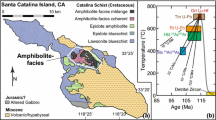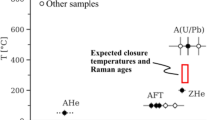Abstract
We have investigated the mechanisms and pathways by which Ar diffuses through the McClure Mountains hornblende (ferroan pargasite), selected as a good example of material normally dated during Ar-Ar studies. A coarse-grained hornblende separated from the same hand specimen as the MMhb-1 age standard was subjected to a hydrothermal cold-seal bomb experiment and characterized by TEM. Heated and unheated crystals were subjected to four different 39Ar/40Ar dating extraction techniques: conventional stepwise heating, infra-red laser spot, ultra-violet laser depth profiling, and closed-system stepwise etching. The stepwise heating age spectrum reproduces the features often interpreted as resulting from a concentric diffusive zonation, but the other three techniques yield results that are not compatible with such a simple picture. The IR laser data indicate that the dependence of laboratory Ar loss on grain size, predicted by Fickian diffusion, is at best poor and instead is related mainly to mineralogical variations. The depth profiles show the importance of planar zones (spaced between <1 and >150 μm from TEM evidence) in providing fast pathways for inward diffusion of atmospheric Ar from the capsule, but showed no evidence of diffusive profiles in the bulk of the hornblende lattice. The data from closed system stepwise etching underscore the role of zones rich in planar defects both for Ar loss and for nucleation of etching. The age spectra obtained by stepwise heating suffer from the differential breakdown of impurity phases, whose presence can be diagnosed with several isotope correlation plots; particularly revealing are Cl-Ca-K trends. In addition to the problems of mineral decomposition during in-vacuo laboratory degassing, an equally important decomposition occurs during many hydrothermal experiments which, combined with problems of mineral purity, have led to an overestimation of the rate of argon diffusion in hornblende. The response of hornblende to thermal disturbance in a hydrothermal environment can be every bit as complex as breakdown in vacuo. Laboratory experiments on bulk samples have not succeeded in quantitatively constraining volume diffusion.
Similar content being viewed by others
Author information
Authors and Affiliations
Additional information
Received: 12 October 1995 / Accepted: 11 July 1996
Rights and permissions
About this article
Cite this article
Villa, I., Grobéty, B., Kelley, S. et al. Assessing Ar transport paths and mechanisms in the McClure Mountains hornblende. Contrib Mineral Petrol 126, 67–80 (1996). https://doi.org/10.1007/s004100050236
Issue Date:
DOI: https://doi.org/10.1007/s004100050236




